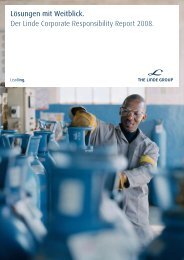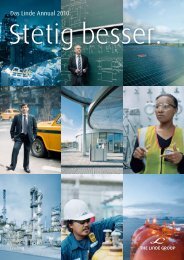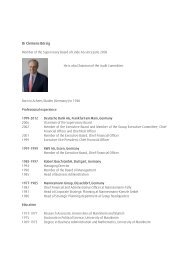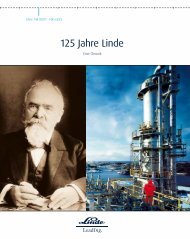The complete history of the development of The - The Linde Group
The complete history of the development of The - The Linde Group
The complete history of the development of The - The Linde Group
You also want an ePaper? Increase the reach of your titles
YUMPU automatically turns print PDFs into web optimized ePapers that Google loves.
From <strong>the</strong> first refrigeration machine<br />
to an independent company<br />
At a sometimes staggering pace and with a great love <strong>of</strong><br />
experimentation, Carl von <strong>Linde</strong> created a new industry within<br />
just a few decades: refrigeration. His engineering company,<br />
<strong>the</strong> “Gesellschaft für <strong>Linde</strong>’s Eismaschinen,” was characterized<br />
from <strong>the</strong> very beginning by innovativeness and close customer<br />
relations.<br />
Carl von <strong>Linde</strong>, a pr<strong>of</strong>essor at <strong>the</strong> Technical University <strong>of</strong> Munich<br />
(see also page 12), had come upon refrigeration as an area <strong>of</strong><br />
research by way <strong>of</strong> a contest for a cooling unit for <strong>the</strong> crystallization<br />
<strong>of</strong> paraffin. “<strong>The</strong> thought immediately struck me: here was<br />
an area <strong>of</strong> mechanical <strong>the</strong>rmodynamics that had not yet been<br />
fully explored,” he said, describing his newly awakened curiosity<br />
in his 1916 memoir “Aus meinem Leben und von meiner Arbeit.”<br />
Von <strong>Linde</strong> immediately set about laying <strong>the</strong> <strong>the</strong>oretical groundwork<br />
for an “improved ice and refrigeration machine.” In his<br />
calculations <strong>of</strong> caloric efficiency, he had come to <strong>the</strong> conclusion<br />
that <strong>the</strong> cold vapor machine promised <strong>the</strong> highest yield <strong>of</strong> cooling<br />
energy as compared to <strong>the</strong> absorption machine and <strong>the</strong> cold<br />
air machine. <strong>The</strong> method he conceived would work with <strong>the</strong><br />
lowest possible temperature differences and use methyl e<strong>the</strong>r<br />
as <strong>the</strong> refrigerant.<br />
Initial contacts with breweries<br />
After von <strong>Linde</strong> had published his ideas in 1870 and 1871 in <strong>the</strong><br />
Polytechnic Association’s “Bavarian Industry and Trade Journal,”<br />
which he also edited, a <strong>development</strong> was set in motion that<br />
would determine <strong>the</strong> direction <strong>of</strong> <strong>the</strong> entire rest <strong>of</strong> his life. His<br />
articles on refrigeration technology had aroused <strong>the</strong> interest <strong>of</strong><br />
brewers who had been looking for a reliable year-round method<br />
<strong>of</strong> refrigeration for <strong>the</strong> fermentation and storage <strong>of</strong> <strong>the</strong>ir beer.<br />
In <strong>the</strong> summer <strong>of</strong> 1871 an agreement was made between<br />
von <strong>Linde</strong>, Austrian brewer August Deiglmayr (Dreher Brewery)<br />
and Munich brewer Gabriel Sedlmayr to build a test machine<br />
according to <strong>Linde</strong>’s design at <strong>the</strong> Spaten Brewery. With <strong>the</strong>ir help,<br />
1880<br />
Cologne Ca<strong>the</strong>dral <strong>complete</strong>d after 632 years <strong>of</strong> construction.<br />
<strong>Linde</strong>’s ideas would be put into practice, so that a refrigeration<br />
unit could <strong>the</strong>n be installed at <strong>the</strong> Dreher Brewery, <strong>the</strong> largest<br />
brewery in Austria, in <strong>the</strong> hot, humid city <strong>of</strong> Trieste (now part<br />
<strong>of</strong> Italy).<br />
Building <strong>the</strong> first <strong>Linde</strong> ice machine<br />
<strong>The</strong> construction plans were finally <strong>complete</strong>d in January 1873 and<br />
<strong>the</strong> patent applied for. <strong>The</strong> Bavarian patent required, however,<br />
that <strong>the</strong> machine be in operation within one year. <strong>The</strong>refore von<br />
<strong>Linde</strong> and Sedlmayr placed an order with Maschinenfabrik Augsburg<br />
that same month to build it. And with some effort <strong>the</strong>y<br />
succeeded in starting operation by <strong>the</strong> important patent deadline<br />
in January 1874. Of course, <strong>the</strong> first machine did have its<br />
difficulties.<br />
<strong>The</strong> main problem was that von <strong>Linde</strong>’s mercury seal did not<br />
work properly so that <strong>the</strong> methyl e<strong>the</strong>r used as <strong>the</strong> refrigerant<br />
leaked out <strong>of</strong> <strong>the</strong> compressor. In <strong>Linde</strong>’s words, “This design was<br />
not a suitable solution for <strong>the</strong> requirements <strong>of</strong> practical use. So it<br />
seemed imperative to build a second machine.”<br />
Sketches and notes from Carl von <strong>Linde</strong>’s early lecture drafts when he<br />
served as an instructor (1868-1879) at <strong>the</strong> Polytechnic School in Munich<br />
(today TU Munich).<br />
7


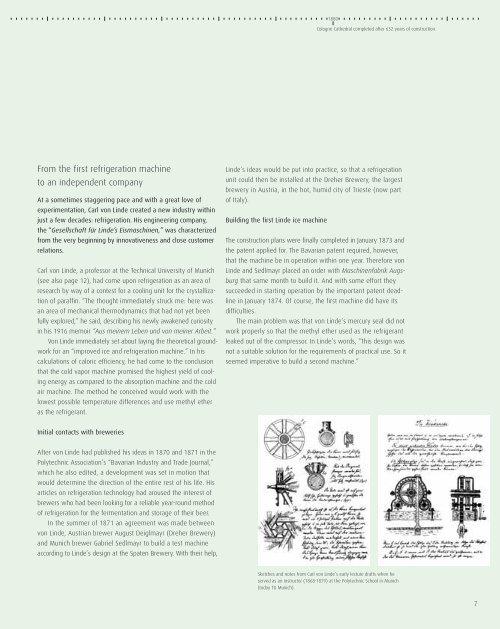
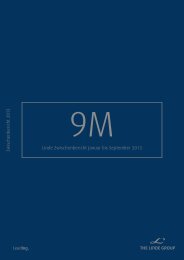
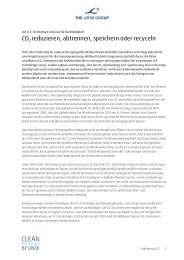

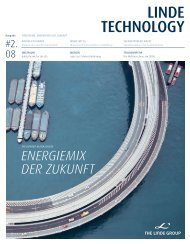
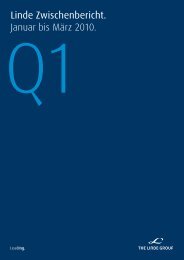
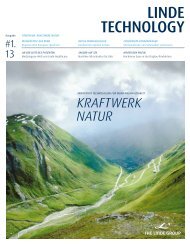

![[41] Anteilsbesitzliste des Linde Konzerns und ... - The Linde Group](https://img.yumpu.com/8356102/1/184x260/41-anteilsbesitzliste-des-linde-konzerns-und-the-linde-group.jpg?quality=85)
![[41] Anteilsbesitzliste des Linde Konzerns und ... - The Linde Group](https://img.yumpu.com/8356076/1/184x260/41-anteilsbesitzliste-des-linde-konzerns-und-the-linde-group.jpg?quality=85)
